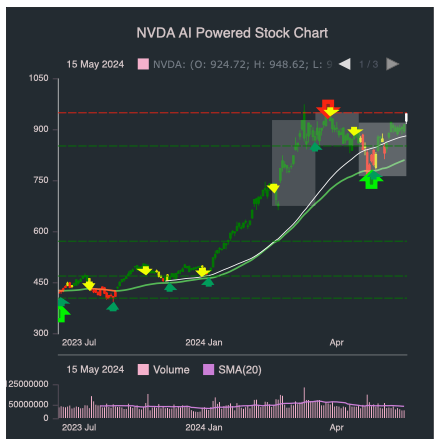20 Recommended Reasons For Picking AI Stock Trading Websites
20 Recommended Reasons For Picking AI Stock Trading Websites
Blog Article
Top 10 Ways To Evaluate The Privacy And Security Of AI stock Trading Platforms
Security and privacy are essential when using AI software for predicting and analyzing stocks since they are often handling sensitive financial as well as personal data. Data breaches or misuses can cause reputational and financial damage. Here are 10 guidelines to determine the security and privacy of these websites.
1. Check the Data Encryption
Security on the move: Ensure that the platform you are using has secure protocols that encrypt your data as it travels between their servers and your device (e.g. TLS/SSL).
Encryption while in transit: Check that the sensitive data stored on the server has been encrypted with strong encryption standards, like AES-256.
End-to-end encryption: Check whether your platform offers encryption from beginning to end for data and communications that are considered to be sensitive.
2. Assess Authentication Mechanics
Two-factor authentication (copyright) Check if the platform supports copyright in order to provide an additional layer of security.
Biometric authentication: Find out whether the platform supports biometric login options (e.g. fingerprints or facial recognition, etc.)) for mobile applications.
Password policies: Check whether the platform follows strict password policies (e.g. minimum length or requirements for complexity).
3. Examine for Compliance
Financial regulations: Ensure that you are in compliance with the relevant financial regulations (e.g. SEC FINRA MiFID II).
Privacy laws for data: Make sure that you adhere to any data privacy laws that are applicable to your business (if applicable) (e.g. CCPA or GDPR).
Audit certifications. Find out if the platform is certified by third-party security tests or has been certified (e.g. SOC 2 and ISO 27001).
Review Controls for Accessing Data
Access based on role: Use access controls based on role to restrict access to data only to authorized users.
Verify that you have the ability to set permissions at granular levels for different users and team members.
Activity monitoring: Verify that the platform records and monitors all user activities for any suspicious behavior.
5. Examine Vulnerability Management
Regular updates: Ensure that your platform is updating its software frequently to patch any vulnerabilities.
Penetration Testing: Verify whether the platform is subjected to penetration tests, which identifies and fixes security vulnerabilities.
Make sure the platform has an incentive to researchers to identify flaws.
6. Evaluate Data Privacy Policies
Transparency Review the platform privacy policies to understand what data you provide, used, or shared.
Data minimization: Ensure that the platform collects only the data needed to run the platform.
Third-party Sharing: Determine if the platform shares data with third-parties and, if it does in what manner.
7. Verify Secure API Use
API security. Ensure APIs use secure authentication techniques (e.g. OAuth keys, API keys), and that data is protected.
Rate limitation - Make sure that the API is fitted with limits on rate to stop abuses or brute force attacks.
Check the access logs to check if they're recorded for monitoring and auditing.
8. Assess the response to an incident and recover
Incident Response Plan: Ensure your platform is well-defined incident response plan for dealing with data breaches.
Verify the platform's notification policy. Does it notify users immediately if there is an incident?
Backups of data: Make sure the platform regularly backups its data and has a disaster-recovery plan.
9. Examine Physical Security Measures
Security of the data center - Make sure that the server for the platform is located in secure data centres with physical security (e.g. surveillance, access control).
Redundancy: Determine if there are redundant platforms running on the platform in order to ensure that data is available in the event of hardware failure.
Examine the geographical distribution of data to ensure resilience.
10. Test the privacy controls of your users
Data deletion: Ensure the platform will allow you to erase your personal information permanently when you cease making use of the platform.
Privacy settings: Verify whether the platform offers privacy settings that control the type of data public or shared.
Verify if an anonymization is being performed on data that's used in analytics or machine learning.
Bonus Tips
User reviews and reputation: Research reviews and feedback from customers to gauge the platform's track record on security and privacy.
Trial period for free: Try the platform's privacy controls and security features using an online demo.
Customer Support: Check that the platform has the capacity to provide a robust support in case of security concerns.
With these suggestions that you follow, you will be able to assess the security and privacy of AI stock predicting/analyzing trading platforms to ensure that your data and financial information are secure. A secure platform not just secures your assets, it also builds trust and confidence in its offerings. Take a look at the top ai for stock trading advice for more tips including investing ai, AI stock trading app, chart ai trading assistant, best AI stock trading bot free, ai for stock predictions, ai trading, incite, AI stock trading, trading ai, options ai and more.
Top 10 Tips On How To Evaluate The Scalability Ai Trading Platforms
To ensure that AI-driven stock prediction and trading platforms are scalable and scalable, they need to be able to handle the increasing volume of data and complexity in markets, in addition to the demands of users. Here are 10 top tips on how to assess the scaleability.
1. Evaluate Data Handling Capacity
Tip: Check if the platform can process and analyze large datasets (e.g., historical stock data, live market feeds, or alternative data like news or social media).
Reason: Scalable platforms are required to be able to handle growing volumes of data without compromising performance.
2. Test the capabilities of Real-Time Processing
Tip: Assess how well the platform handles real-time data streams for example, live stock prices, or breaking news.
What is the reason? Trading decisions that are real-time require real-time data analysis. Delays could lead to missed opportunities.
3. Cloud Infrastructure and Elasticity: Check it out
Tips: Find out if the platform uses cloud-based infrastructure (e.g., AWS, Google Cloud, Azure) and can scale resources dynamically.
Why: Cloud-based platforms provide elasticity. They permit the system to scale down depending on demand.
4. Algorithm Efficiency
Tip: Assess the computational power (e.g. deep learning and reinforcement learning) of the AI models used for prediction.
Reason: Complex algorithms can consume a lot of resources So optimizing these algorithms is crucial to ensure scalability.
5. Learn about Parallel Processing and Distributed Computer Systems.
Check whether the platform utilizes distributed computing or parallel computing frameworks.
Why: These technologies allow more efficient data processing and analysis across multiple nodes.
Examine API Integration. API Integration.
Tips: Make sure that your platform integrates with other APIs, like brokers and market data providers. APIs.
Why: Seamless platform integration ensures it can adapt to any new data sources or trading environments.
7. Analyze User Load Handling
Try simulating high traffic levels to see the performance of your platform.
What's the reason? The performance of a scalable platform is not affected by the growth in users.
8. Review the Model Retraining Adaptability
Tip: Examine how often and effectively the AI models are retrained with new data.
Why: As markets change the models need to be updated quickly to remain accurate.
9. Verify that Fault-Tolerance and Redundancy are in place.
Tip - Make sure that your system has redundancy and failover mechanisms for handling hardware or other software malfunctions.
Since downtime can be expensive in trading Fault tolerance is a must to scalability.
10. Monitor Cost Efficiency
Tip: Consider the cost of scaling up your platform. Be aware of cloud resources like data storage and computing power.
It's crucial to keep a balanced equilibrium between the expenditures and costs for performance.
Bonus Tip: Future-Proofing
Make sure the platform can adjust to changes in regulations and incorporates new technologies, like quantum computing or advanced NLP.
If you focus your focus on these factors and focusing on these factors, you can evaluate the capacity of AI prediction as well as trading platforms. This ensures that they are durable, efficient, and also ready for further expansion. Have a look at the most popular stock trading ai advice for site recommendations including AI stock predictions, AI stock predictions, ai for trading stocks, ai options trading, stocks ai, best stock prediction website, chart ai trading, ai copyright signals, best AI stocks, AI stock prediction and more.